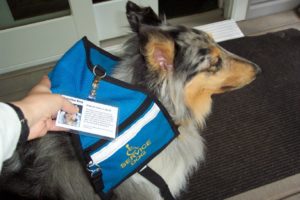Pet dog owners often learn in puppy classes how to handle and prepare their puppies for nail trims, brushing, bathing and other grooming. Service dogs have the same needs, however, for owners with disabilities dog care may be more challenging and may require modification. Some simple strategies and training can often make things much easier.
Facilitating Daily Care
Train service dogs behaviors that make daily care easier. No one wants to chase after a dog to put a leash on, but a person with a disability may not be able to. Teach the service dog to move towards the owner when the owner picks up the leash and to put his head through a vest or collar on cue. Also, train the dog to stand still while the owner clips the harness, collar or vest. Positive training techniques like luring, targeting and even shaping can be used to teach these behaviors.
Nail trims can be difficult for people who have limitations with using their hands. For some owners, using a dremel can make things easier. Owners who are not able to use a clipper or dremel may still be able to use a dog nail file and reduce the need for frequent trims.
Solidify basics like “stand” and “stay,” to help with grooming, bathing and with equipment fitting. Teach the dog to be comfortable on a raised surface like a grooming table.
Sometimes simple strategies can make all the difference. Wiping-off muddy paws can be exhausting. Owners can place mats near the door that the dog can be cued to walk on to reduce or even eliminate the clean up. While easy strategies like this may seem obvious to a professional dog trainer, they may not be to an owner-trainer who is new to living with a dog.
Helpful Gadgets
Look at the ergonomics of the grooming tools, usually wider handles are easier for people with limited hand use. Foam tubing can be used to make brushes and combs easier to hold. Also consider the weight, size and materials of food and water bowls. Raised bowls, while designed to make things easier for some dogs, can actually make things easier for an owner who has difficulty bending.
Incorporate Task Training
Some service dog tasks can double as behaviors helpful for husbandry. For example, the owner can cue the dog to retrieve an empty food or water bowl, or to bring a leash closer. Facilitate grooming by incorporating behaviors like the long down needed for Deep Pressure Therapy and stand-stay for brace.
Picking Up after the Dog
An act that seems simple although unpleasant, can be difficult or impossible for a person with a disability. For people with mobility impairments, bending over to clean up after the dog can put them at risk of a fall. There are various types of clean up devices that can reduce or eliminate the need to bend and reach. Don’t forget the training piece. If the dog is on leash and pulls or darts after a squirrel while the owner is cleaning up, the owner can fall. Take time to reward the dog for waiting.
Maintain Equipment
Teach service dog owners how to check and maintain the dog’s equipment. Tape-rollers can help remove hair from velcro and a wet wash cloth can remove dirt from vests and harnesses. Owners need to check leashes, harnesses and clasps routinely to ensure they are secure and functioning properly.
Keep in mind that fatigue can be an issue for people with disabilities. An owner who is tired from caring for the dog has less energy for training practice. Taking the time to troubleshoot husbandry routines can make a big difference for both the owner and the dog.

